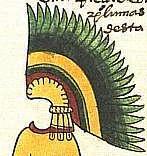Related Research Articles

Ahuitzotl was the eighth Aztec ruler, the Huey Tlatoani of the city of Tenochtitlan, son of princess Atotoztli II. His name literally means "Water Thorny" and was also applied to the otter. It is also theorized that more likely, the animal called ahuitzotl is actually the water opossum, the hand symbolizing its prehensile tail, which otters notably lack.

Cuitláhuac or Cuitláhuac was the 10th Huey Tlatoani (emperor) of the Aztec city of Tenochtitlan for 80 days during the year Two Flint (1520). He is credited with leading the resistance to the Spanish and Tlaxcalteca conquest of the Mexica Empire, following the death of his kinsman Moctezuma II.

Motecuhzoma Xocoyotzin, variant spellings include Moctezuma, Motewksomah, Motecuhzomatzin, Montezuma, Moteuczoma, Motecuhzoma, Motēuczōmah, Muteczuma, and referred to retroactively in European sources as Moctezuma II, was the ninth Emperor of the Aztec Empire, reigning from 1502 or 1503 to 1520. Through his marriage with Queen Tlapalizquixochtzin of Ecatepec, one of his two wives, he was also king consort of that altepetl.

Tizocic or TizocicatzinNahuatl pronunciation:[tisosiˈkat͡sin̥] usually known in English as Tizoc, was the seventh tlatoani of Tenochtitlan. His name means, "He who makes sacrifices" or "He who does penance." Either Tizoc or his successor Ahuitzotl was the first tlatoani of Tenochtitlan to assume the title Huey Tlatoani to make their superiority over the other cities in the Triple Alliance clear.

Acamapichtli was the first Tlatoani, or king, of the Aztecs of Tenochtitlan, and founder of the Aztec imperial dynasty. Chronicles differ as to the dates of his reign: according to the Codex Chimalpahin, he reigned from 1367 to 1387; according to the Codex Aubin, he reigned from 1376 to 1395; and according to the Codex Chimalpopoca, he reigned from 1350 to 1403.

Huitzilihuitl or Huitzilihuitzin was the second Tlatoani or king of Tenochtitlan. According to the Codex Chimalpahin, he reigned from 1390 to 1415, according to the Codex Aubin, he reigned from 1396 to 1417 and according to the Codex Chimalpopoca, he reigned from 1403 to 1417.

Tlacopan, also called Tacuba, was a Tepanec / Mexica altepetl on the western shore of Lake Texcoco. The site is today the neighborhood of Tacuba, in Mexico City.

The Aztec Empire or the Triple Alliance was an alliance of three Nahua city-states: Mexico-Tenochtitlan, Tetzcoco, and Tlacopan. These three city-states ruled that area in and around the Valley of Mexico from 1428 until the combined forces of the Spanish conquistadores and their native allies who ruled under Hernán Cortés defeated them in 1521.

Don Diego de Alvarado Huanitzin was a 16th-century Nahua noble. A grandson of Axayacatl, Nephew of tlatoani Moctezuma II. He was initially the tlatoani (ruler) of Ecatepec before becoming tlatoani of Tenochtitlan, as well as its first governor under the colonial Spanish system of government.

The Aztecs were a Pre-Columbian Mesoamerican people of central Mexico in the 14th, 15th, and 16th centuries. They called themselves Mēxihcah.

Don Andrés de Tapia Motelchiuh Huitznahuatlailótlac, also known as Motelchiuhtzin, was the ruler of Tenochtitlan (1525–1530).

Don Pablo Xochiquentzin was a ruler of the Aztecs.

Don Diego de San Francisco Tehuetzquititzin was the 16th tlatoani and second governor of Tenochtitlan.

Don Luis de Santa María Nanacacipactzin, also known as Cipac, was the last tlatoani ("king") of the Nahua altepetl of Tenochtitlan, as well as its governor (gobernador) under the colonial Spanish system of government. The previous ruler Cristóbal de Guzmán Cecetzin having died in 1562, Nanacacipactzin was installed on September 30, 1563, and ruled until his death on December 27, 1565.
Don Juan de Guzmán Itztolinqui was a post-Conquest tlatoani (ruler) of the altepetl of Coyoacán in the Valley of Mexico.

Tlilpotonqui or Tlilpotoncatzin was the second cihuacoatl ('president') of Mexico-Tenochtitlan.
Don Juan de Santo Domingo de Mendoza Tlacaeleltzin Chichimeca teuctli was the tlatoani (ruler) of Itztlacozauhcan in Amaquemecan, Chalco from 1548 to 1563.

Don Cristóbal de Guzmán Cecetzin was a colonial Nahua noble from Santa María Cuepopan in San Juan Tenochtitlan. A son of the ruler don Diego Huanitzin, don Cristóbal first served as alcalde in 1556 before becoming Tenochtitlan's next-to-last tlatoani and third governor in 1557, titles he held until his death in 1562.

Chimalpilli II was a Tlatoani (ruler) of the Nahua altepetl (city-state) Ecatepec, in 16th-century Mesoamerica.
References
- Williams, Barbara J.; Harvey, H. R. (1997). The Códice De Santa María Asunción: Facsimile and Commentary: Households and Lands in Sixteenth-century Tepetlaoztoc. p. 64.